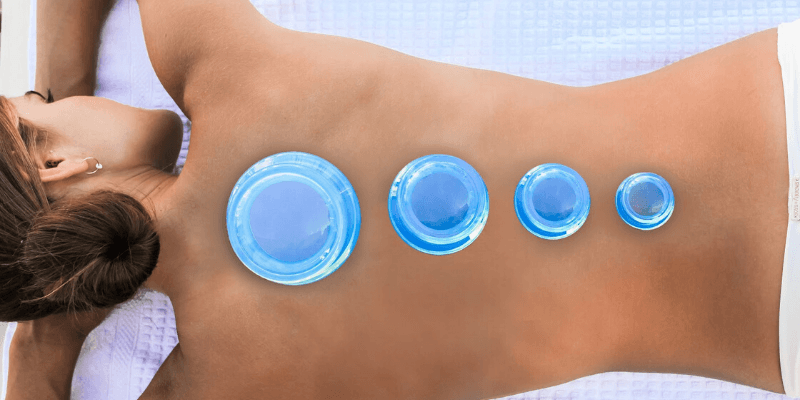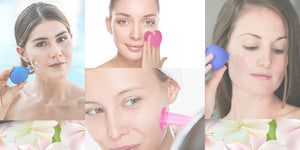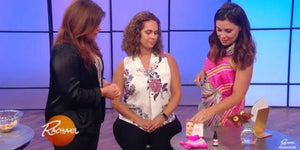What is Cupping Therapy?
Even before the cupping marks across Olympian Michael Phelps’ back generated hundreds of thousands of Internet searches in the summer of 2016, cupping therapy was utilized since ancient times in different cultures across the globe. A source of muscle relaxation and post-workout therapy for many, cupping therapy can help rid the body of toxins, improve digestive performance and relieve built-up stress.
Cupping therapy is a form of alternative medicine where glass, silicone or plastic cups are placed on the skin to create vacuum suction in order to promote health and healing. Cupping therapy promotes the loosening of soft tissue and connective tissue, scarring and adhesions, moving stagnation and increasing lymphatic flow and circulation. The simple, traditional therapy method shares the benefits of deep tissue massage and muscle relaxation, without lofty fees or a commitment to hours of therapy time.
Cupping Therapy: The Basics

Who is It For?
Almost anyone can benefit from cupping. Lure Essentials cups are extremely user-friendly and can be used in a professional or home setting, alone or with a partner. Cupping therapy is for anyone with 3-5 minutes of free time, looking for an easy way to address sports injuries, muscle and joint pain, connective tissue (fascia), digestive problems and respiratory issues like colds and coughs.
Many people love cupping therapy because of its simplicity. At-home users can easily apply cups to assist in muscle and joint pain relief, digestion and more. Professional athletes benefit from cupping to improve in-game performance and shorten recovery periods. Whether you’re a high-profile athlete, a working professional or a curious bystander, you too can enjoy the many benefits of cupping therapy, in a matter of minutes.
NOTE: Do not cup on an empty stomach or during periods of fasting. Do not cup if you are on blood thinners, have a history of heart disease or diabetes. Avoid cupping therapy if you are energetically depleted (low blood pressure, elderly, children, etc.). For more information on cupping therapy best practices, check out the “Safety, Contra-Indications and General Protocols” reference in our Practical Guide to Cupping.
Before You Begin
Before we can walk you through easy cupping therapy techniques to transform your stress relief, digestive health, post-workout recovery and more, you need a cupping set of your own. If you’ve somehow managed to survive without your own set of therapy cups, we’re here to help pick the best set for you, when you’re ready. This is our recommended favorite set for any first-timers. There’s so many ways to take advantage of the most affordable beauty modality on the market: Athleticism, Beauty, Healthy Digestion, Loosen Muscles, and so many ways to cup while doing so!

Waiting for your cupping set to arrive? Sit tight, it’s on its way. Don’t worry; we’ll be here when you’re ready.
Once you’ve unboxed your cupping therapy set, you’re only a few simple steps from the benefits of at-home cupping therapy!
Different Ways to Cup
Decide on cup size and cupping method before you begin your cupping therapy session.
First, you’ll want to settle on a cup size. Use large cups to disperse strong suction over a larger area and small cups for smaller areas or contour massage. Use a large cup with consistent suction to loosen adhesions, stagnation, and for trigger point release.
Next, you’ll want to decide on a cupping technique. Your silicone cups can be easily used to perform four cupping therapy techniques: static cupping, flash cupping, dynamic (gliding/massage) cupping and shake/rotation cupping.
1. Static Cupping
Static cupping therapy involves cup placement in a single area, without movement. Before beginning, add water or any type of lubricant – one that doesn’t quickly absorb into skin – to the area you intend to cup. Compress the cup to create vacuum suction. Leave the cups on the skin for 3-5 minutes, starting with 3 minutes for the first session and gradually increasing the time. If the cup pops off, reposition and re-apply to skin. You may use the static cupping technique several times a week for up to 10 days, then take a break.
2. Flash Cupping
Flash cupping is the repeated placement and release of cups on the skin. Squeeze the cup to create vacuum suction, place on the skin, release and repeat. Perform flash cupping rounds for up to 15 minutes per area on the body. Flash cupping can help relieve congestion and sinus pressure. It’s great for deep tissue release to minimize discomfort of a cupping massage.
3. Dynamic (Gliding/Massage Cupping)
Dynamic cupping is the gliding or sliding of cups across the skin. Apply oil or any quality lubricant to dry skin or use on wet skin with body wash or soap in the shower. Compress the cup to create vacuum suction. Glide the cup in a zig-zag, circular or up-and-down motion. Complete the method by draining toward lymph nodes. It is safe to perform dynamic cupping 1-3 times per week, for a total of 5-20 minutes. Take a break to restore energy levels.
For more information on dynamic cupping, see the “Lymphatic Drainage Chart” in our Practical Guide to Cupping.
4. Shake/Rotation Cupping
Shake/rotation cupping therapy is the movement of cups when in the static position. Shake or rotate cups side-to-side. Shake/rotation cupping is effective for softening scars, deep tissue work, trigger points and myofascial release.
Post-Cupping Therapy
Avoid chills, drafts or excessive heat for up to 6 hours post-cupping. When the body has to fight to keep from internal cold, it makes the treatment less effective. Avoid steam, sauna and any other types of body treatment like massage or other bodywork manipulation for the next 48 hours.
You may wish to pay attention and keep track of changes in your body, such as sleep patterns, appetite, thirst, mood, energy, elimination of fluids and solids, clothing fit, digestion, pain levels, endurance, athletic recovery time and any other changes you notice.
Although it’s tempting to jump into the shower immediately after a cupping therapy session ends, it’s best to wait. Instead, allow your skin the time it needs to recover. After a few hours, you’re in the clear for a quick shower. It’s also essential to stay well hydrated after cupping, in order to help the body flush away toxins. Alcohol dehydrates the body, so it’s best to avoid any substances during the first 24 hours after cupping therapy. Instead, increase your fluid intake to replace what is naturally flushed. Lastly, avoid strenuous exercise after concluding a cupping session. Instead, spend time enjoying some well-deserved rest and relaxation.
Cupping Therapy: The Benefits
Forms of cupping therapy have benefited users since the fourth century. With some exceptions, cupping therapy benefits users because of increased blood circulation to target areas. Cupping therapy can prove its worth in a matter of minutes.
Cupping for a Better Digestive System
Cupping therapy serves as an effective remedy for sometimes debilitating digestive roadblocks. If you’re dealing with constipation, flatulence, irritable bowel syndrome or other digestive health issues, cupping therapy can minimize downtime and put you back on your feet. Whether you’re looking to improve your appetite, foster bowel regularity or simply promote gastrointestinal health, cupping therapy may provide relief after only a standard 3-5 minute cupping application. Many users note more regular bowel movements after digestive cupping therapy.
Many cuppers use flash cupping for digestive benefit. Cups are applied to the abdominal area, then released from the body, then re-applied. Begin this flash cupping technique at the center of the abdomen, gliding the cups over intestinal areas. This process follows an L-shaped path across the abdomen, mimicking the removal of waste from the body. Flash cupping for digestion can help eliminate the blockage of waste products in the body and can clear intestinal passages.
Cupping for Improved Athletic Performance & Recovery
Cupping therapy can directly benefit athletes, improving in-game athletic performance and slashing post-workout recovery times. Athletes can enjoy tension relief, particularly across problem muscle areas.
Proper athletic cupping typically calls for larger cups, given the larger muscles - hamstrings, buttocks, etc. - requiring attention. However, athletes attempting to target specific areas can also incorporate smaller cups, placed near or atop the affected muscles. Cupping therapy can directly benefit fascia layers beneath the skin, especially helpful in speeding up athletic recovery.
Whereas post-workout massage therapy for athletes may last hours, cupping for athletic purposes lasts only 3-5 minutes. In return, athletes can benefit from an increased range of motion, as well as improved circulation and decreased muscle pain.
Athletes regularly benefit from both static and glide cupping. No matter the method, these localized cupping techniques can return athletes to the court or the field sooner than athletes who recover without the help of alternative medicine.
Cupping for Improved Muscle Relaxation
Anyone suffering from tight muscles, tension headaches, lactic acid buildup or muscle spasms understands the importance of muscle relaxation. Fortunately, cupping therapy is known to help release muscle tension.
Both static and glide cupping methods are useful in soothing tensed muscles. Focus your cupping efforts on the skin above sore or tight muscles, for relief in minutes. After a long day at the office, an especially strenuous workout routine, poor sleep patterns or other stressful or muscle-tensing activities, there’s nothing like a quick cupping therapy massage to relax muscles and surrounding joints.
Cupping to Improve Skin Contour
A 3-5 minute cupping therapy session can benefit your skin quality, contour and elasticity. Small cups can make big changes to your skin: cupping therapy has been known to fortify wrinkle lines and open your pores, releasing toxins from the body. Bolstered facial and skin beauty can start with a regular cupping regime.
Glide your small cups across either the face or other target areas during your 3-5 minute therapy session. It is important that cups are kept in motion while applied to more sensitive areas of the body, preventing cupping-caused marks. While these marks are simply the byproducts of harmful toxins leaving the body, they can be avoided by keeping cups in motion across the skin.
We Answer Your Cupping FAQs
No matter your experience in the world of cupping therapy, you’re going to have questions. That’s why we’re here to answer any and all of your questions. We’ve outlined commonly asked cupping questions below, along with our response. If you don’t see an answer to your cupping therapy question, feel free to contact us for a quick response from one of our cupping experts.
FAQ #1 – Is some discomfort normal?
Some discomfort is normal. However, cupping users should also feel relaxed during a session and after it ends. Eventually, your discomfort should be replaced by a feeling of relaxation. If your discomfort persists, or if you experience pain at any point, stop use and reach out to our certified cupping experts.
FAQ #2 – Should I be concerned about the marks on my skin?
You may notice marks on the skin after your cupping session concludes. The discolorations produced after cupping are often the result of toxin buildup brought to the surface, stagnation, previous injury or lactic acid produced by the muscles.
If redness or itching occurs, it’s likely due to inflammation brought to the surface.
FAQ #3 – Can I perform cupping therapy if I’m pregnant?
Cupping therapy is still allowed during pregnancy, with specific conditions. Pregnant women are encouraged to participate only in light or moderate cupping use. Use only the flash cupping method to move edema and excess fluids only. Avoid cupping only the lower and upper abdomen. Cups can be applied to the lower back until the 6th month of pregnancy.
FAQ #4 – How long should cups remain on my skin?
Cups should remain on the skin no longer than 3-5 minutes. First-time users may want to begin by only leaving cups on the skin for 30 seconds to a minute at a time, before removing and assessing their skin’s reaction. Cups that remain on the skin longer than 5 minutes can negatively affect your skin and wellbeing.
FAQ #5 – Where should I place the cups?
Generally, cups can be applied nearly anywhere on the body that allows for suction. However, cups should never be used on the genitals, orifices, or any area that causes an unpleasant sensation. Popular target areas for cups include large muscle-layered regions, such as the thighs, back and buttocks.
To prevent suffocation, do not use over nose or mouth. Avoid cupping on the neck over jugular or carotid arteries (or any other site with prevalent blood vessels). Do not cup over varicose veins, bulging discs or lesions. Do not cup over acute psoriasis, eczema or rosacea, hives, herpes, shingles, raised moles or skin cancer.
For more information on recommended cup placement, see the “Cupping Reference Chart” in our Practical Guide to Cupping.
FAQ #6 – Does cupping involve fire?
It’s a common myth that fire must be incorporated into cupping therapy. In fact, most professional cupping applications are fully functional today without the help of fire. Today, soft silicone cups are capable of sufficient suction without the use of any fire. Furthermore, these silicone cups are sanitary, easily transportable, long-lasting and usable for a wide variety of target areas on the skin.
FAQ #7 – How do I care for my cups?
Silicone cups from Lure Essentials can be washed in warm, soapy water, both before and after use on skin. Wipe down cups with alcohol wipes, or clean with a 50% water, 50% Listerine mixture. Glass cups with rubber bulbs can be wiped with alcohol pads, or cleaned with the 50% water, 50% Listerine mixture. Avoid getting liquid inside the bulb. If bulbs can be safely removed, glass cups can be washed in warm, soapy water. To clean Bio-Magnetic cups, first remove magnets. Wash the cups in warm, soapy water. Clean the tubing with Listerine or alcohol. Do not use products containing essential oils with any plastic cups.
NOTE: Do not boil or microwave cups. Silicone cups are not dishwasher safe.
Remember: Results are cumulative, and practice makes perfect! Happy cupping!
For more cupping variations and safe home practice, check out Magnolia Wellness' informative blog post.
MEDICAL DISCLAIMER
This content is for informational and educational purposes only and is not intended to diagnose, treat, cure or prevent any disease or medical condition. The information provided is not intended to provide medical advice or to take the place of such advice or treatment from a medical professional or physician. Consult your doctor or qualified health professional if you have any health questions. Neither Lure Essentials or publisher of this content takes responsibility for possible health consequences of any person or persons reading or following the information in this educational content. Product reviews listed on this website are real reviews from real users. However, individual results may vary. The statements or efficacy of these products have not been evaluated or confirmed by FDA-approved research.






